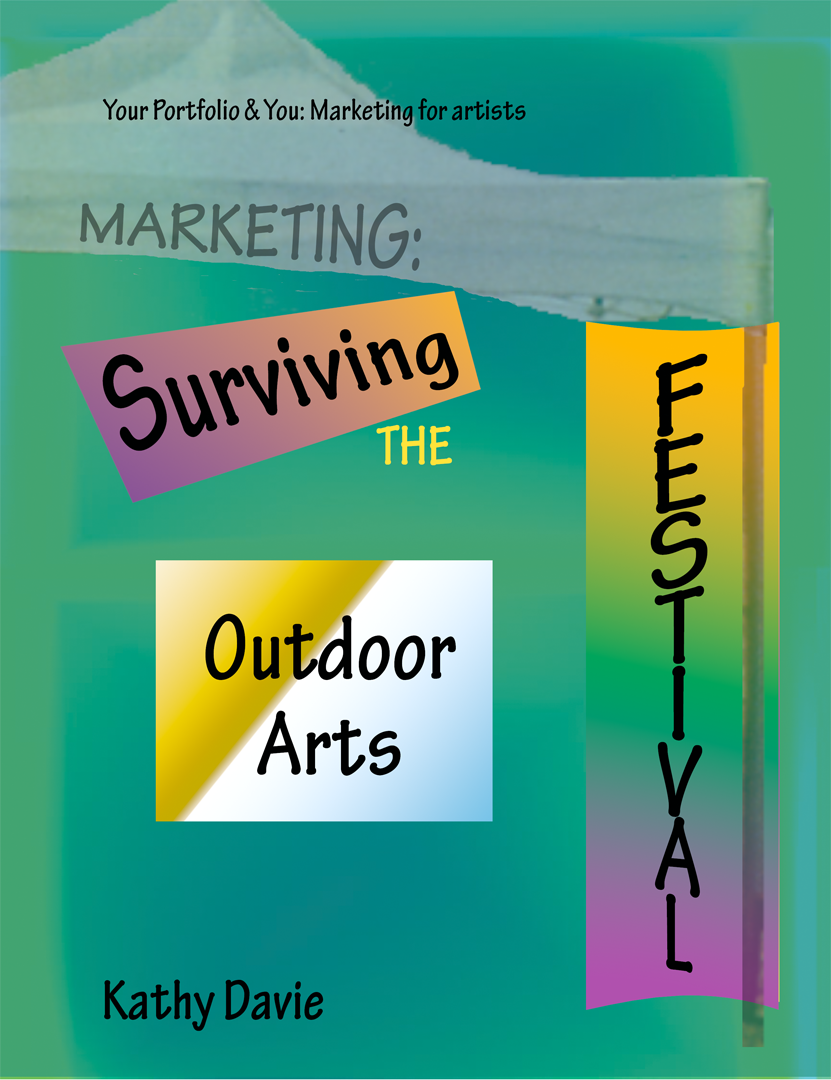- Print list price: $16.95
- Download list price: $6.95
- ISBN: 978-0-557-77049-6
- Published: June 2011
- Publisher: Lulu.com
- Number of pages: 118
- Book Detail: Black-and-white paperback with color cover, 8.5″ x 11″
- Instructions Included: Two sets of step-by-step instructions
THE PURPOSE:
It was exciting. It was a nightmare. It was total confusion and a major learning experience.
An experience I want to pass on to other artists and crafts people. To anyone who is about to step foot into an outdoor event to sell a product or a service.
Table of Contents in Surviving the Outdoor Arts Festival
- Introduction
- Coding Used Within This Book
- Choosing the Right Show
- Entering the Arts Festival
- Image Choices
- Booth Slide
- You’re In…Now What?
- The Booth
- Making Your Own Tent
- Weighting Your Tent
- The Booth
- The Displays
- What is a display?
- Designing the Display
- Security and Traffic Flow
- Storage
- The Officework
- Color & Texture
- Where Can I Get This Display Stuff?
- Create Your Own Display Units
- Display Panels
- Pedestals
- Creative Displays
- Can I Decorate My Display?
- The Psychology of Display
- Lighting Your Display
- The Down-and-Dirty Approach
- Floors
- Original Work
- Reproductions for Sale
- MC/Visa
- Basics of Accepting Credit Cards
- Merchant Accounts
- Payment Gateway
- Shopping Cart Applications
- Credit Card Terminals
- Fees
- One-Time Fees
- Annual and Monthly Fees
- Monthly Minimum Fee
- Internet Gateway Fee
- Daily Fees
- Per-Transaction Fees
- Chargeback Tips
- Hidden Fees
- Also Ask…
- Credit Cards, Debit Cards, eChecks
- Equipment
- Software
- Mobile Credit Card Processing Applications
- Tips on Security and Fraud Prevention
- Brochures
- Headshot
- Business Cards
- Mailing list
- Guest Books
- Class Schedules
- Portfolio Pages
- Signage
- Shopping Bags
- Prepare an Elevator Speech
- Sitting Down to Write Your Marketing Pitch
- Get Feedback
- “Memorize” Your Pitch
- The Physical Delivery
- Futureproof Your Pitch
- Plan a Demonstration
- Insurance
- Materials & Tools Needed
- Cutting
- Materials & Tools Needed for 4 Pipe Weights
- Assembly
- Assemble the Velcro Strap
Surviving the Outdoor Arts Festival is all about…
Getting in…and up!
Entering any outdoor arts festival, prestigious or local, is exciting. And you are entering a whole new world where your art is only 10% of the entire effort while the appearance and functionality of your booth accounts for 60% to 70% (Moore).
This self-help manual includes a a practical exercise in how to sell yourself and your art; suggestions for improving your being accepted into the show, tips, lists of suppliers, suggestions, little extras that make your clients and yourself more comfortable, and checklists on prepping for and surviving the outdoor arts festival.
Facts about the booth/tent and its design (buying or creating what is needed); displaying, lighting, and shipping your work; publicity you should consider; signage; insurance and nighttime security; what you must know about MasterCard and Visa; maximizing your artwork’s profitability; prepping and closing the sale; and, the after-show chores.
Step-by-step Instructions included in Surviving the Outdoor Arts Festival
Darcy Meeker’s instructions on Build[ing] Your Own Nesting, Lighted Pedestals
Create Your Own Pipe Weights
Downloadable forms include
A spreadsheet to help with merchant account comparisons (one version in Excel and another saved as a Numbers file).
A marketing pitch outline ranging from 30 seconds to 2 minutes.
From Chapter 6: The Product
MC/VISA
Basics of Accepting Credit Cards
The basics of accepting credit cards are that you need a merchant account (bank) and a credit card terminal (gadget or software that enables someone’s credit card to be used to make a purchase); add a payment gateway if you want to accept credit cards on your website or an outdoor arts festival.
The merchant account is an arrangement with a financial institution that allows you to accept credit cards, also known as credit card processing. Part of this arrangement is that you pay all sorts of fees ranging from one-time to annual to monthly to per-transaction.
The credit card terminal is either a mechanical machine that slides over the credit card making an impression onto a transaction slip (not-so-fondly referred to as a knuckle buster), a keypad machine into which you type the numbers and contact information of the buyer (your laptop can also act as a keypad credit card terminal), a swipe machine (swiper) which you/the buyer slides through a slot on the side as it automatically notes the necessary information, or a Virtual Terminal (you login to your merchant account through your computer thus using the computer as the terminal). Ideally, you will have real-time access to the Internet via a telephone line—land or cellular.
Merchant Accounts
Absolutely nothing is easy when it comes to figuring out the best type of merchant account to open. There are at least five different kinds of accounts: retail, Internet, mail order, store-and-forward, and wireless. The retail expects that at least 80% of your transactions will be through a dedicated credit card terminal. The Internet requires both a merchant account and a payment gateway although some companies such as PayPal 13, 2Checkout 14, and ClickBank 15 will act as both; be cautious about taking on an Internet account with a standard bank as opposed to a merchant service (unless this is a one-off arrangement). Banks tend to see an Internet account as too scary and will charge you accordingly. Mail order is usually considered a card-not-present situation and must be punched in via keypad (card-not-present and using a keypad are charged higher rate fees). Store-and-forward is for situations
From Chapter 7: The Publicity
Mailing List
Your mailing list is incredibly valuable. With it, you have taken a step toward targeting the people who are interested in your artwork. Use it to inform every person who ever expressed an interest in or has purchased your artwork, your friends and family, art columnists, events editors in newspapers, promotional blogs, social networks, etc., of your participation in the show.
Any art show will have a postcard printed up to promote itself. Participating artists receive a set number of these show-specific postcards to send out to their particular mailing list. Sometimes, the individual artist will have a postcard printed up for several shows which they send out to their mailing list detailing the event(s) along with the dates for the show(s) and their locations. Another option is a press release, which you send out to arts editors in the media. Don’t forget to include the social networking sites, business networking sites, photo-sharing, twitter, as well as blogs which promote artists and/or arts festivals (Google “blog art festivals, art promotion”).
Table 5. Promotional Sites of Interest to Artists
| Social Networking |
| Business Networking |
| Bookmarking |
| Image Promotion |
| Twitter-like |
From Chapter 8: Working the Sale
Prepare an Elevator Speech
When festival-goers approach your booth, you will need different length marketing pitches of anywhere from 15 seconds to three minutes. Think of this as an elevator speech in which you tell people who you are, what you do, and how it will benefit them:
I create artwork for (ideal client) so that they can (benefit to the client).
The 15-second pitch:
- Tell the viewer who you are
- State the medium in which you work BUT, keep in mind that the buyer is in your booth, It’s going to be pretty obvious what your medium is so come up with something that states what is unique about your artwork:
- Talk to your current clients and friends. Ask them what they find unique or fascinating about your work.
- What do you feel sets you apart from other artists in your particular medium?
- Be sure that the words you use are relevant to the here and now
- Include your competitive advantage, how you can perform better than anyone else
- Find the “hook” that will grab your listener’s attention, prompt him/her to ask questions, and keep the conversation going
The 30-second to 1-minute pitch:
- How are you different/unique from other artists? Other artists in your medium?
- … then to the “several minutes pitch” on through the “intense pitch” and ending with step 11, the “close of your pitch”

Kathy Davie is an editor, author, and artist with degrees in Technical Writing & Editing, Digital Media, and History from Metropolitan State College in Denver, Colorado.
A huge believer in knowledge being power, Kathy has an ongoing and free set of Author Tools for authors interested in self-editing with an ongoing series of posts on Word Confusions, what’s Properly Punctuated, those tricky Formatting Tips, and the sleep-inducing Grammar Explanations. There is also an online tutorial on Using Microsoft Word’s Markup Tool.
And if you get too sleepy, explore KD Did It for various writing and editing services.


Leave a Reply